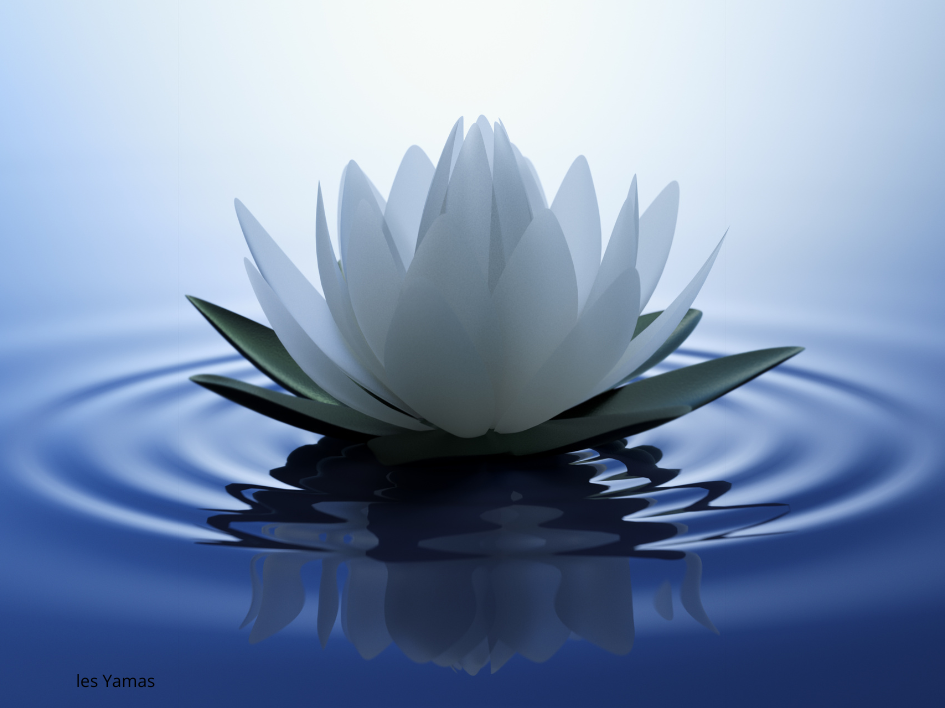The Yamas in Yoga Philosophy: A Guide to Harmonious Living!

Yoga, in its true essence, goes far beyond the physical postures we frequently see in studios and on social media. It is a complete system of personal, spiritual, and ethical development that aims to create a balanced life, both physically and mentally. One of the most influential works that describes this system is Patanjali’s Yoga Sutras , a foundational text that structures the practice of yoga into eight interdependent branches (or “limbs”). This eight-step path is known as Ashtanga yoga .
The very first of these branches is called the Yamas . The Yamas represent universal ethical principles, guidelines for living in a moral and harmonious way. These rules of conduct concern not only how we interact with others, but also how we behave with ourselves. They form the basis on which an authentic yoga practice can develop.
These ethical principles are often compared to the precepts of different religions, but in yoga they are not imposed as rigid rules. Rather, they are recommendations that invite introspection and personal transformation. Understanding and practicing the Yamas not only improves our daily lives, but also deepens our yoga practice.
There are five main Yamas, each with its own meaning and implications for modern life: Ahimsa (non-violence) , Satya (truth) , Asteya (non-stealing) , Brahmacharya (restraint) , and Aparigraha (non-attachment) . These principles provide an ethical framework that can transform the way we live, both on the yoga mat and in everyday life.
The 5 Yamas: The Universal Ethical Principles
Ahimsa (Non-violence)
Ahimsa, often translated as "non-violence," is one of the central concepts not only of yoga, but also of several Indian spiritual traditions, such as Hinduism, Buddhism, and Jainism. This Yama goes far beyond the obvious idea of not physically harming others. It also encompasses non-violence in our thoughts, words, and actions.
Ahimsa in Daily Practice
On the yoga mat , Ahimsa manifests itself in how you treat your own body. Pushing your body beyond its natural limits can be a form of violence to yourself. Yoga practice, when infused with Ahimsa, encourages respecting your body’s capabilities and listening to its signals. If a posture causes pain, it may be a sign to adapt or leave it alone for the time being. The goal is not to force the body into perfect form, but to find harmony between body, mind, and breath.
In daily life , Ahimsa can be practiced in relationships with others. This can mean avoiding aggressive behavior or hurtful words, even in conflict situations. Ahimsa encourages you to respond to challenges with patience and compassion rather than anger or resentment. It also includes how you speak to yourself. How often have you judged yourself harshly or spoken harshly when faced with failures or mistakes? Practicing Ahimsa means learning to treat yourself with the same kindness and gentleness that you would show a dear friend.
Finally, Ahimsa also has an ecological dimension . Being nonviolent toward the planet means making conscious decisions that minimize environmental damage. This can manifest itself in dietary choices (such as vegetarianism or veganism, which are often associated with Ahimsa in yogic traditions), more sustainable consumption decisions, or actions to protect local and global ecosystems.
Satya (Truth)
Satya, meaning "truth," is the second Yama. Like Ahimsa, Satya is not limited to a literal interpretation. Truth, in the philosophy of yoga, is not only not lying, but also living authentically and in alignment with one's deepest values.
Satya in Daily Practice
On the yoga mat , Satya invites you to be honest with yourself about your abilities and limitations. It’s easy to get caught up in your ego and want to do advanced postures or keep up with the pace of a class, even if your body isn’t ready. Satya reminds you to be honest about your physical and mental state. If you’re tired, stressed, or injured, acknowledging and accepting that is a form of truth that allows you to practice yoga in a more conscious and respectful way.
In daily life , Satya pushes you to live your truth, to be consistent between what you think, what you say, and what you do. Sometimes this involves difficult conversations or choices that may be uncomfortable. For example, telling the truth to someone you love, even if it may displease them, is a Satya practice. However, it is important to remember that Ahimsa and Satya must work together. Telling the truth should always be done with kindness and respect, so as not to cause unnecessary suffering.
Satya also involves being honest with yourself in finding what truly makes you happy. Too often, we are influenced by the expectations of society, family, or friends, and we pursue goals that do not match our true desires. Practicing Satya is learning to listen to your own inner voice and make choices that are in line with your deepest values.
Asteya (absence of flight)
Asteya, which means “absence of theft,” may seem obvious at first. We all know that it is wrong to take what does not belong to us. But in the context of the Yamas, Asteya goes far beyond simply not stealing material objects. It is an invitation to cultivate generosity and to avoid any form of covetousness or appropriation.
Asteya in daily practice
On the yoga mat , Asteya means not stealing energy from others or yourself. This can be manifested by respecting each other's practice time, not distracting others in the class, or avoiding monopolizing the teacher's attention. Asteya also invites you not to steal your own well-being by constantly comparing yourself to others, or by seeking to outdo others in your practice.
In daily life , Asteya can be practiced in many ways. For example, respecting others' time by arriving on time for an appointment, or not interrupting someone while they are speaking, are forms of Asteya. Not stealing others' ideas or creations, always acknowledging each other's contributions, is also an important practice.
Asteya also has a more subtle dimension that touches on our relationship with the environment. Consuming more than you really need, accumulating material goods without having any real use for them, can be considered a form of theft from the planet's limited resources. Asteya invites you to cultivate simplicity and take only what you need, in order to leave enough for others and for future generations.
Brahmacharya (Moderation)
Brahmacharya is often misunderstood. Traditionally, this Yama was associated with celibacy for monks and renunciated yogis, but for most modern practitioners, Brahmacharya is instead understood as moderation and energy management. This principle encourages us to use our energy consciously and responsibly, without excess or waste.
Brahmacharya in Daily Practice
On the yoga mat , Brahmacharya manifests as the balance between effort and rest. This means that you should neither overexert yourself during your practice nor allow yourself to become lazy. The key is to find a happy medium, using your energy efficiently and intentionally. Brahmacharya can also involve becoming aware of how you use your mental and emotional energy during your practice. Are you distracted by outside thoughts? Can you refocus your attention on your breathing and movement?
In daily life , Brahmacharya invites us to examine our habits and avoid excessive behaviors. This can include managing our desires and impulses, whether in food, sex, alcohol consumption, or entertainment. The goal is not to deprive ourselves, but to cultivate a healthy balance that allows us to live fully without depleting our physical, mental, or emotional resources.
Practicing Brahmacharya also means learning to preserve and channel our life energy (prana) for activities that nourish our long-term well-being. For example, rather than spending hours scrolling through social media, you could use that time for activities that rejuvenate you, such as meditation, reading, or spending time in nature.
Aparigraha (Non-attachment)
The last of the Yamas, Aparigraha, means "non-attachment" or "non-accumulation." This principle invites us to cultivate detachment from material possessions, results, and expectations. Aparigraha does not advocate total destitution, but rather an attitude of letting go that frees us from the obsession with possessing and controlling.
Aparigraha in daily practice
On the yoga mat , Aparigraha manifests as letting go of outcomes. When you practice a posture, the goal is not to achieve “perfect form” or succeed at all costs. Rather, it is about fully experiencing the experience, being present in the moment, without attachment to outcomes. Cultivating Aparigraha in your practice also means accepting your current limitations without judging or comparing yourself to others. Every body is different, and what matters is the journey, not the destination.
In daily life , Aparigraha helps us release attachments that can cause suffering. We live in a society that values accumulation, whether it is material goods, professional success, or relationships. However, these attachments can often lead to anxiety, stress, and fear of losing what we have. Aparigraha invites us to embrace the impermanence of life, to live with gratitude for what we have, while being willing to let go when things change.
This principle can also be applied to relationships and the expectations we have of others. Cultivating Aparigraha is learning to love without attachment, to give without expecting anything in return, and to live fully without being a prisoner of expectations or unfulfilled desires.
How to Incorporate the Yamas into Your Daily Yoga Practice
Practicing the Yamas in your daily life and yoga practice does not require radical changes. Rather, it is a continuous awareness and intention to align your actions with these ethical principles. Here are some practical suggestions for integrating each Yama into your routine:
Practicing Ahimsa Daily
- On the yoga mat : Respect your body by avoiding pushing yourself into postures that cause pain or excessive discomfort. Use props to adapt postures to your needs.
- In daily life : Cultivate kindness towards yourself and others. Avoid negative thoughts and hurtful words. Take care of the environment by making ecological choices.
Practicing Satya Daily
- On the yoga mat : Be honest with yourself about your limits and needs. Listen to your body and don't let your ego guide you.
- In everyday life : Living your truth can mean making choices that reflect your values, even if it goes against the expectations of society or others.
Practicing Asteya Daily
- On the yoga mat : Respect the time and space of others during practice. Don't compare yourself to others or try to "steal" their progress.
- In daily life : Practice generosity by sharing what you have with others, whether it is your time, your resources, or your ideas.
Practicing Brahmacharya Daily
- On the yoga mat : Find a balance between effort and rest. Don't overwork yourself, but don't fall into laziness either.
- In daily life : Moderate your desires and habits. Manage your energy in a way that nourishes your long-term well-being.
Practicing Aparigraha Daily
- On the yoga mat : Let go of the idea of achieving perfection in the postures. Be present in the experience, without fixating on the results.
- In daily life : Practice detachment by freeing yourself from obsession with material possessions and expectations. Learn to live in the present moment with gratitude.
The Benefits of Yamas for Yoga Practice and Personal Well-Being
Incorporating the Yamas into your daily life and yoga practice can have many benefits, both physically, mentally and spiritually. Here are some of the main benefits:
- Stress Reduction : By practicing the Yamas, you learn to live with more inner peace. Ahimsa, for example, helps you cultivate non-violence towards yourself, thereby reducing anxiety related to self-criticism. Aparigraha, by encouraging you to let go of material and emotional attachments, reduces unnecessary sources of stress.
- Improved Interpersonal Relationships : Yamas like Ahimsa and Satya promote harmonious and honest relationships. By applying these principles, you can improve your interactions with others, being more understanding, empathetic and authentic.
- Strengthening Inner Harmony : By living according to the principles of the Yamas, you create coherence between your thoughts, words and actions, which strengthens your personal integrity and inner balance.
- Spiritual Development : The Yamas open the way to deep spiritual development. They connect you to higher values and help you transcend selfish desires to live a more fulfilling life aligned with your spiritual essence.
- Better connection with yourself : Practicing the Yamas allows you to know yourself better, understand your deep motivations and live more consciously. It helps you make decisions that are in line with your values and life goals.
Conclusion
The Yamas are more than just ethical rules; they are guides to living a life of meaning, peace, and harmony. By incorporating them into your yoga practice and daily life, you can transform your life and that of others around you. Each Yama offers a unique perspective on how to live consciously, respectfully, and in alignment with your values.
The path of yoga is an inner journey, and the Yamas are the crucial first steps. By practicing Ahimsa, Satya, Asteya, Brahmacharya, and Aparigraha, you open yourself to a life of serenity and wisdom . Continue to explore these principles, and discover how they can enrich not only your yoga practice, but every aspect of your life.


















